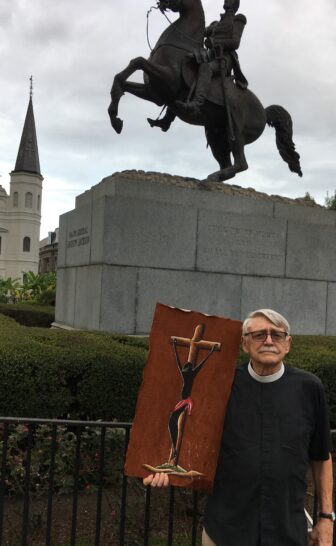
We hear over and over again about how both police and demonstrators allow passionate feelings to become violent actions — take Charlotte, Baltimore, Chicago and Ferguson, for example, scenes of bloody mayhem that have attracted abundant press coverage.
An yet, on a recent Saturday, one of the largest demonstrations in recent New Orleans history received little if any national attention. The occasion was a Take ‘Em Down NOLA event, in which over 600 spirited protesters walked from Congo Square to Jackson Square in support of initiatives to remove monuments to Confederates, slave owners and, in the case of Andrew Jackson, also a leader in efforts to rid the eastern United States of Native Americans.
Yes, there were arrests, seven of them stemming from confrontations so minor that most of us didn’t even see them. Does there have to be violence to make the headlines? Why not more news about peace making, even when difficult issues divide us? Certainly we need that as we approach next month’s presidential elections.
We protesters were prepared to be arrested if necessary, but the demonstration leaders did not ask us to cross the barrier police had set up around the Andrew Jackson monument. I saw several very angry men leaning against the barrier yelling at the police, condemning them for protecting the monument, as if its removal were an NOPD decision. But the police did not return the anger. They stayed rigidly calm and, as far as I could tell, acted with complete professionalism — the way we expect law-enforcement to act.
As a child of the white South, I had somewhat mixed feelings about Take ’Em Down NOLA. I appreciate the importance of honoring our heritage and learning about historical figures — perhaps especially those who, like all of us, made significant mistakes. They are part of who we are, and we need to know them.
In my former church, Trinity Episcopal, in New Orleans, the largest meeting room is named for the first Episcopal bishop in Louisiana, Leonidas Polk. Besides owning over a hundred slaves, Polk later became a general in the Confederate Army. We used to have thoughtful discussions at Trinity about renaming Bishop Polk Hall, but so far Trinity has decided to keep the name, a way of assuring that we will never forget.
At the same time, most Trinity members delight in the fact that many anti-racism workshops and racial reconciliation meetings have taken place right there in Bishop Polk Hall, including those offered by one of the strongest anti-racism organizations in the country: The People’s Institute for Survival and Beyond, headquartered here in New Orleans. I wonder if Bishop Polk is smiling or frowning as he looks down at our effort to reconcile the races in his special room. (I’d like to think he is smiling.)
So, I understand, to some extent the effort to preserve all of our monuments, even those from the Confederate and slave-holding past. But I am much more moved by how important removal of the monuments is to virtually all of my African-American friends.
I had to weigh what I see as the historical significance of keeping the monuments against the anger, the hurt, the sadness that the monuments cause so many African Americans in this city.
In my so-called retirement years, I have the privilege of working closely with many people in the black community, of all ages — all the way from the all-youth Mardi Gras Indian tribe, the Red Flame Hunters, to participants in Justice and Beyond who meet weekly at Christian Unity Baptist Church. With leaders in faith, labor and politics, including a variety of community activists, Justice and Beyond is becoming, I believe, the strongest voice for African Americans in the city. No surprise, many of the Take ’Em Down protesters are part of Justice and Beyond.
So, I had to weigh what I see as the historical significance of keeping the monuments against the anger, the hurt, the sadness that the monuments cause so many African Americans in this city. It eventually became clear to me that the monuments need to come down. I am aware of just how important symbols are to all of us, but perhaps especially to the black community.
As a South Carolina native, I applauded when, in 2000, Charleston Mayor Joseph Riley, who is white, walked 120 miles from Charleston to Columbia to take down the Confederate flag from the state capitol. (Until recently it remained on the state capitol grounds but now has been removed altogether.)
With that important symbolic walk, Riley opened the door to further racial reconciliation, including the astonishing and inspiring ability of Mother Emanuel AME Church to forgive the Confederate flag-waving young man, Dylann Roof, who shot nine members of the black church’s Bible study group. Taking down the monuments will open the way to a similar kind of racial reconciliation in our own city.
I was afraid there might be violence — whether initiated by white or black people (or both) — so I carried on my shoulder a fine framed painting of a black Jesus on the cross, sent to me from a friend in Africa. I thought it might make everyone think twice before caving in to mayhem.
My black Jesus wasn’t necessary. The police acted professionally; the demonstrators, at least as far as I could see, made their witness (our witness) peacefully. The only insult I received came from a David Duke supporter. When he was through preaching at me, I said, “See this man up here on the cross, whether black or white, he died for you!” He smiled before he walked away.
The Rev. William Barnwell, an Episcopal priest, is the author of four books tracing his evolution as a Christian, from boyhood in segregated Charleston, S.C., to the continuing struggle against racism in New Orleans today. His latest book is “Called to Heal the Brokenhearted,” published by the University Press of Mississippi.


